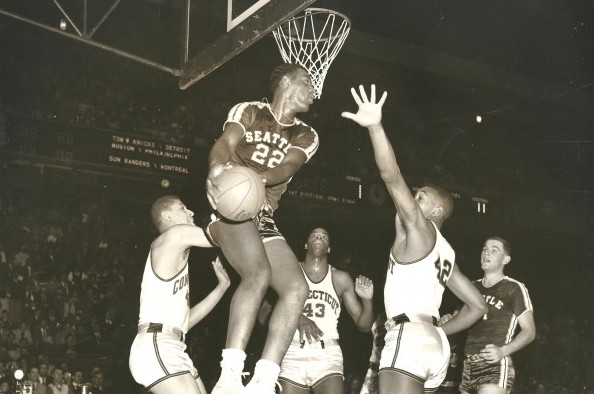
By David Eskenazi and Steve Rudman
Anyone who has paid attention to the NBA Draft Lottery over the past quarter of a century (usually held during the fourth week of May) is probably familiar with Elgin Baylor’s tough-to-watch appearances on the Secaucus, N.J., dais on behalf of the Los Angeles Clippers, a franchise so historically abysmal that it occasionally served as monologue fodder for Johnny Carson on The Tonight Show.
A playing legend, Baylor endured these televised embarrassments, in which representatives of the NBA’s worst teams, sans only their dunce caps, gawked as 14 numbered ping pong balls tumbled in a standard lottery machine to determine drafting order. Baylor appeared in his capacity as Clippers general manager or, perhaps more aptly in his case, the “general mis-manager”.
Baylor held that position for 22 years, from 1986 through 2008, during which the Clippers lost 50 or more games 15 times, 65 or more five times, and miraculously missed the can’t-miss playoffs 18 times. Only four times in Baylor’s tenure did the Clippers reach the postseason, exiting as first-round casualties three times.
In all, Baylor presided over 356 wins and 1,308 defeats. Not one of his teams won 50 games in a season. Six of his clubs won fewer than 20. Twelve of his clubs finished last in the Pacific Division, and five others plodded home next-to-last.
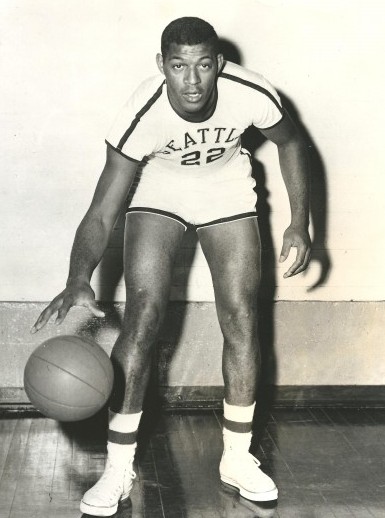
How Baylor kept his job amidst such rampant boobery can be explained by Baylors odd relationship with nickle-and-dime team owner Donald T. Sterling, who provided Baylor with the years necessary to amass a dossier of doofism unrivaled in modern American sport, and few resources to do anything about it.
Not once in 22 years did Baylor select a player in the NBA Draft who made Rookie of the Year despite drafting in the top 10 on 10 occasions. Not one Clipper made the first, second, or third All-NBA Team on Baylor’s watch.
Baylor had opportunities to draft Scottie Pippen, Reggie Miller, Shawn Kemp, Sean Elliott, Kevin Garnett, Kobe Bryant, Steve Nash, Dirk Nowitzki, Jason Terry, Jamal Crawford, Vince Carter, Amare Stoudemire, and a host of other talented players, but always wound up with the Michael Olowokandis and Bo Kimbles of the world. His penalty for their play: an annual cameo at the Draft Lottery, where he came, rightly or wrongly, to symbolize Clipper incompetence.
The NBA named Baylor its “Executive of the Year” in 2006, after the Clippers astonished by winning 47 games. In hindsight, the league must have figured it had better salute Baylor while it had the chance since, for L.A’s No. 2 NBA team, this was probably as good as it would ever get.
Baylors second life in Los Angeles exists in amazing contrast to his first, when he became the alpha part of a gene sequence that would come to include Connie Hawkins, Julius Erving, Michael Jordan and Kobe Bryant. Which is to say, Baylor pioneered the athletic art of jumping in the air, changing his mind three times, and making something spectacular happen before he hit the floor.
Unfortunately for Baylor, the bulk of that career exists largely in black and white (where it exists at all) while the lamentable (Clipper) part of it got televised in color. For younger audiences, unfortunately, Baylor is defined more by his role with the Clippers than by his mind-blowing, game-changing stunts with a basketball.
Elgin Gay Baylor his father named him after his favorite wrist watch — came out of Washington, D.C., where he had been a superb athlete at Spingam High School. He enjoyed a subsequent, three-year residency in Seattle due to preternatural basketball ability and less-than dazzling scholarship skills, which had forced him to drop out of high school at one point and work in a furniture store.
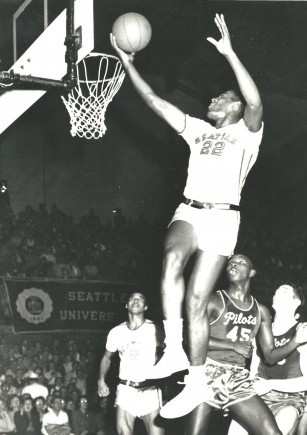
No college with academic integrity would touch Baylor when he emerged from high school, but the College of Idaho (Caldwell, Idaho), harbored no illusions of becoming the Harvard of the West. It offered him a scholarship, expecting Baylor to play football and basketball. College of Idaho already employed an athlete cast in a similar mold, a football-basketball sensation and noted leaper named R.C. Owens, from Santa Monica, Calif.
Baylor and Owens became friends and roommates, and may have formed the greatest small-college athletic tandem since future Pro Football Hall of Famers Joe Perry and Hugh McElhenny starred together in the same Compton (Calif.) Junior College backfield in 1946 and 1947.
Perry and McElhenny later played together with the San Francisco 49ers (1952-59), after McElhenny made a much-celebrated detour at the University of Washington (1949-51), and McElhenny teamed with R.C. Owens late in his tenure in San Francisco (1957-59). It was there that Owens caught those famous Alley-Oop touchdown passes from Y.A. Tittle (essentially a jump ball in which Tittle threw it high in the end zone and Owens would go up and get it), and became the only player in NFL history to block a field goal (1962 vs. Washington) after positioning himself directly under the crossbar and leaping high to swat it away. The NFL soon legislated Owens goaltending tactic out of existence.
During their one year together at College of Idaho, Baylor averaged 31.3 points and 18.9 rebounds, and Owens 19.0 points and 21.1 rebounds, once snatching a school-record 37.
Before Baylor could play a second year in Caldwell, the College of Idaho fired its head basketball coach and cut back on athletic scholarships, eliminating Baylor from future plans. Seattle auto dealer Ralph Malone, involved in a new basketball venture, contacted Baylor and urged him to transfer to Seattle University, while simultaneously offering him a chance to play on a Northwest AAU League team Malone was sponsoring during the year Baylor would have to sit out until he established his athletic eligibility.
Seattle U. head basketball coach Al Brightman made the official announcement of Baylors transfer from College of Idaho on Thursday, May 26, 1955, saying, He will be with us starting with the 1956-57 basketball season. Just think about what a team he will make for us. I think Baylor is going to be pretty good.
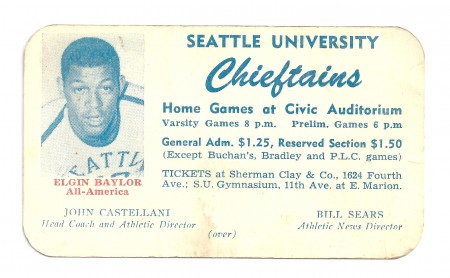
With that, Brightman forever retired the trophy for understatement.
Baylor stood 6-5, weighed 225 pounds and dazzled onlookers with a hanging jump shot in an era when other players, mostly white dawdlers, lofted running hooks, arced two-handed set shots and rarely dunked. To those players, awed at the shoot, slash and crash game Baylor invented, he must have been a spectacle of the highest magnitude.
Baylors first Seattle team, Malone’s Westside Ford, had just joined the Northwest AAU (Amateur Athletic Union) League, and was coached by former Chieftains All-American Johnny OBrien, back in Seattle for the baseball offseason after having completed his second year with the Pittsburgh Pirates.
A collection of mostly business-sponsored, or “industrial league”, clubs, the Northwest AAU League consisted of Westside Ford, Puhich Cleaners, Darigold Farms, Federal Old Line Insurance, the Buchan Bakers, Fort Lawton and Val Kirk Pharmacy. Former University of Washington (notably Dean Parsons, Frank Guisness, Charlie Koon and Joe Cipriano) and Washington State stars dotted the rosters, and R.C. Owens, Baylors former teammate at College of Idaho, had signed with Buchan (Owens did not join the 49ers until 1957 and often used the threat of jumping to the NBA to improve his NFL contract).
Newspapers of the day did not splurge much ink on the Northwest AAU League prior to Baylors arrival, but practically doubled its coverage once he did.
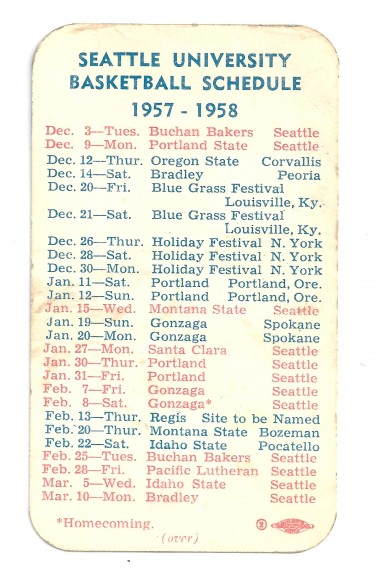
The 20-year-old Baylor played his first game for Westside Ford on Nov. 23, 1955, scoring 28 points in a 56-51 victory over Puhich Cleaners. He dropped 32 points in his second game three days later and 34 more in a 78-77 win over the Buchan Bakers on Nov. 30.
Through the course of the nine-month AAU season, Baylor averaged more than 30 points and 19 rebounds, showing so much that the Minneapolis Lakers selected him in the first round of the 1956 NBA Draft, a choice the Lakers ultimately had to cede (scouting being primitive, if non-existent) when they discovered Baylor had completed only one year of college, thus making him ineligible for the draft.
Remarkably, Baylors already-bloated numbers improved when he joined the Chieftains (now Redhawks), and can be summarized this way: Since 1896 (115 years ago), four different Washington Husky players (Bob Houbregs three times) have scored 40 or more points in a game. Since 1901 (110 years ago), five different Washington State Cougars (Brian Quinnett twice) have scored 40 or more in a game.
In the 1956-57 (sophomore) and 1957-58 (junior) seasons, Baylor produced nine games of 40-plus points, four of 50-plus points and one in which he tallied 60. Among Baylors biggest sprees:
- Nov. 30, 1956, vs. the University of Denver: In the opening round of the Idaho State Invitational in Pocatello, and in his first game for Seattle U., Baylor knocked down 15 field goals and 10 free throws in a 67-60 victory, finishing with 40 points and 18 rebounds.
- Jan. 6, 1957, at the University of Portland: In the second of back-to-back games against the Pilots, Baylor had 41 points and 23 rebounds. In the first, had 33 points and 21 rebounds for a two-day total of 74 points and 44 rebounds.
- Jan. 20, 1957, at Gonzaga: Baylor tallied 44 points with 17 rebounds and even scored a basket for the Zags on an errant tip-in. His effort was the best by a Seattle U. player against Gonzaga since Johnny OBrien scored 51 in 1953.
- Feb. 11, 1957, vs. Buchan Bakers: Baylor had 54 points and 20 rebounds. The defending AAU champions featured former Husky Dean Parsons and R.C. Owens, Baylors former roommate at College of Idaho.
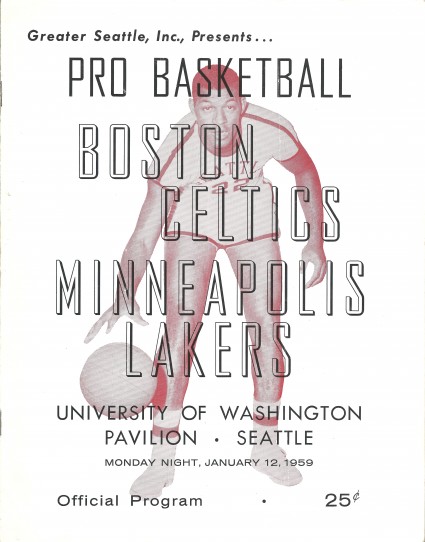
Feb. 18, 1957, vs. Gonzaga: Baylor scored 26 of his 40 points in the second half despite being double and triple teamed. He also moved to No. 4 in the nation in scoring with an average of 29.13 (added 21 rebounds). Seattle University won easily.
- Feb. 26, 1957, vs. Portland: With 51 points (and 20 rebounds), Baylor reached 692 points for the season, a national record for a sophomore, and broke the Seattle U. record for field goals, his 280 snapping OBriens 1951 mark of 275.
- Jan. 12, 1958, at Portland: Baylor had 28 points (of his 48 total, plus 17 rebounds) by halftime, prompting Portland coach Al Negratti to state, Its the best Ive ever seen Baylor play. Hell be a great pro player. Hes strong as an ox, too.
- Jan. 15, 1958, vs. Montana State: After Seattle Us 108-83 victory, in which Baylor scored 53 points and grabbed 22 rebounds, MSU coach Dobbie Lambert marveled, Baylors just fantastic. He certainly has a variety of shots. Some Ive never seen before.
- Jan. 30, 1958, vs. Portland: Seattle U. wiped a 19-point Portland lead at Seattle’s Civic Auditorium inside the final three minutes with Baylor knocking down 20 of his 60 points (to go with 14 rebounds) in the final 7:15.
- Jan. 31, 1958 vs. Portland: A record crowd of 6,100 in Civic Auditorium watched Baylor score 43 points and snatch 22 rebounds, block numerous shots and set up baskets for teammates in what became an 84-80 victory.
- Feb. 7, 1958, vs. Gonzaga: Gonzagas 7-4 French freshman, Jean Claude Lefebvre, had 26 points. When Lefebvre and Baylor (42 points, 19 rebounds) met for a jump ball, the 6-5 Baylor out-jumped Lefebvre and whacked the ball into the bleachers.
- Feb. 8, 1958, vs. Gonzaga: Baylor (46 points, 30 rebounds) took over the national scoring lead at 33.7 points per game from Cincinnatis Oscar Robertson (32.9) and Kansas Wilt Chamberlain (32.7).
- Feb. 13, 1958, vs. Regis College: In a game played at Everett High School, Regis threw up a zone to thwart Baylor, but he had 28 points by halftime en route to 48 (and 22 rebounds), and the Chieftains rolled 99-69.
- Feb. 28, 1958, vs. Pacific Lutheran: Baylor (51 points, 37 rebounds) improved his scoring average to 34.5 points per game, and his 37 rebounds established a Seattle U. single-game record as the Chieftains won 94-60.
- March 14, 1958, vs. San Francisco, NCAA Tournament: Baylor scored 35 points, had 17 rebounds and hit a 40-foot buzzer beater as Seattle U won by two. It was the greatest one-man performance Ive ever seen, said California coach Pete Newell.
- March 21, 1958, vs. Kansas State, Final Four: Despite sitting out eight minutes of Seattle U.s 73-51 romp, Baylor scored 23 points and grabbed 22 rebounds.
- March 22, 1958, vs. Kentucky, Final Four: Baylor scored 25 points despite a rib injury and finished the two Final Four games with 48 points and 41 rebounds. He won the MVP award despite playing on the losing side in the national championship game.
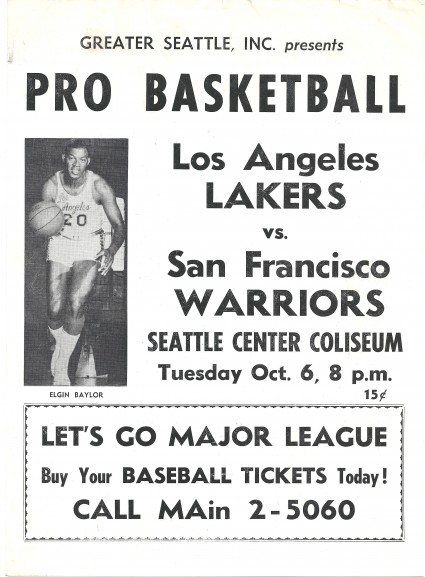
Elgin Baylor returned to Seattle on Oct. 6, 1964, and scored 24 points in the Lakers' 127-102 exhibition victory over the San Francisco Warriors in front of 6,850 fans at the Seattle Coliseum (note Greater Seattle Inc.'s plug for Major League Baseball; also note that five years after Baylor's first pro appearance in Seattle the price of a program had dropped 10 cents). / David Eskenazi Collection
Baylor had one more year of collegiate eligibility after Seattle U.’s first and only appearance in the Final Four, but turned professional when the Minneapolis Lakers offered him $20,000 (a tremendous sum at the time), essentially to save their franchise. In a 1971 Los Angeles Times interview with then-Lakers owner Bob Short, Short said, If he (Baylor) had turned me down then, I would have been out of business. The club would have gone bankrupt.”
So Baylor skipped his senior year at Seattle U., leaving with a 31.3 scoring average and a 19.1 rebound mark in three collegiate seasons (one at College of Idaho and two at Seattle U.).
Nearly a decade removed from the championship clubs anchored by George Mikan, the Lakers went 19-53 the year before Baylors arrival, and suffered financially. In Baylors first year, they improved by 14 games, going 33-39 as Baylor easily won the leagues Rookie of the Year award by averaging 24.9 points and 15.5 rebounds. He had no more trouble amassing gaudy numbers against NBA teams than did against the Buchan Bakers and Darigold Farms of the Northwest AAU League, or any of the college teams he dominated.
Baylor went on to make 11 NBA All-Star appearances. From 1960-61, he averaged 34.8, 38.3 and 34.0 points. At one time, he held the league record for most points in a game (71) and most in a playoff game (61). He scored more than 50 points 11 times and had 11 consecutive 30-point playoff games.
In 1962-63, Baylor became the first player in league history to finish in the top five in scoring (34.0), rebounding (14.3), assists (4.8) and free-throw percentage (.837). In all, Baylor averaged 27.4 points and 13.5 rebounds during his 14-year career with the Minneapolis and Los Angeles Lakers, and in 134 playoff games, he averaged 27.0 points and 12.9 rebounds.
No set of numbers defined Baylor more than the ones he posted in an abbreviated, 48-game, 1961-62 season when, as an Army reservist, he spent every weekday consigned to a Washington state military base. On weekends he flew out to meet the Lakers, wherever they might be playing. In those 48 weekend games and, without the benefit of practice, he averaged 38.3 points, 18.6 rebounds and 4.6 assists.
Knees that could no longer sustain Baylor forced him to retire nine games into the 1971-72 season, his first basketball setback, which led to two more. The Lakers’ first game after Baylor’s retirement became the starting point of an NBA-record 33-game winning streak. The Lakers also went on to win that seasons NBA Championship, something Baylor never achieved in eight trips to the Finals.
Baylor tried his hand at coaching, becoming an assistant and then head coach of the New Orleans Jazz in 1974. He ultimately joined a long line of great players ill-equipped to coach and retired three years later with a record of 86-135, a mark that oddly foreshadowed his second life in Los Angeles, the two decades he spent scraping bottom with the Clippers.
In Baylors first three seasons running the Clippers, they went 12-70, 17-65 and 21-61. In 22 seasons, he burned through 10 head coaches. In 1989, Baylor received one of the biggest insults of his athletic life when Duke’s Danny Ferry elected to sign with an Italian team, wanting nothing to do with the mess over which Baylor presided. Manning wouldn’t even negotiate with Baylor, who was forced to trade Manning as a result of the snub.
Not long after Baylor became Clipperland GM, Jan Hubbard of the Sporting news wrote, The perfect Clipper is Benoit Benjamin, perhaps the premier underachiever in the league. All you need to know about Benjamin is that he once went to an exhibition game with two left sneakers.
Shortly thereafter, Bob Ryan of The Boston Globe wrote, Im surprised they (the Clippers) dont have a couple of guys wearing black socks and wrist watches out there.
No matter how bad things got, Baylor lingered on, principally because Sterling paid him handsomely to serve as a custodian with no real power, rather than as a general manager with clout or say so. Sterling tightly hoarded his coins, permitted Baylor no payroll flexibility and refused to allow Baylor to enter into any long-term contracts. All that was on Sterling, and Baylor accepted it. But the procession of lottery flops and poor records fell on Baylor, the public face of a franchise so woeful that even Sterling occasionally heckled his team from the stands (especially during free throws), much to the chagrin of Clipper players.
Baylor is often called a forgotten pioneer for advancing a style of play two decades ahead of its time. But he is not forgotten by any who watched him, usually spellbound. For those who didnt have that luxury, Baylor will simply go down as the most enduring and least effective sports executive in the annals of games playing.
Baylor could have quit on Donald T. Sterling and the Clippers at any time and avoided that fate. He could have become a Nike spokesman, or anything that would have helped preserve a semblance of dignity. Baylor elected not to. Then, just before the 2008-09 season, Sterling quit on Baylor, firing him after 22 years. The 74-year-old Baylor sued, charging unlawful termination based on age discrimination, while also accusing Sterling of inflicting mental and economic distress. Baylor sought $2 million.
Two years later, on March 30, 2011, a seven-man, five-woman jury voted 12-0 that Elgin Baylor had no claim.
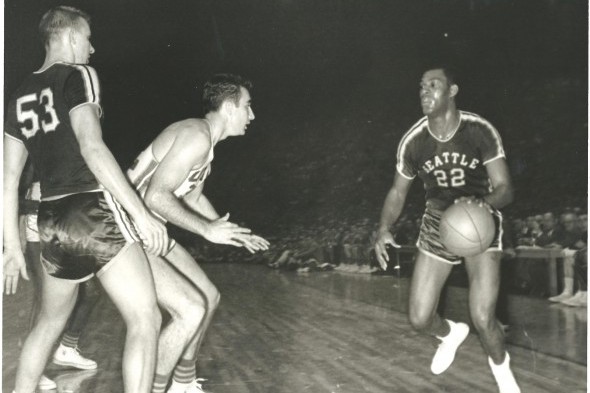
——————————————
Davids Wayback Machine Archive. David can be reached at (206) 441-1900, or at seattlesportshistory@gmail.com
——————————————
(Wayback Machine is published every Tuesday as part of Sportspress Northwests package of home-page features collectively titled, The Rotation.)
——————————————–
Note To Readers: If you have an historical topic you would like explored in the Wayback Machine, please leave your idea in the Comments section that accompanies this article.

5 Comments
I really enjoyed this article. I remember those AAU teams from when I was a kid. We would choose up sides and both teams wanted to be the Buchan Bakers.
Good story. Too bad not many have seen him play in person. It truly was amazing! Just for the record….Ralph Malone owned Westside Ford not Monroe.
Thank you, Maxxdogg. Ralph Malone was my grandfather. He did indeed own Westside Ford and loved Elgin Baylor. I have a wonderful B&W photo of Elgin and my grandfather standing beside a Ford vehicle.
I saw Baylor play two games live, one in the Civic Auditorium, and, earlier, I believe, in the Civic Ice Arena.
Seemed like one of the games featured the floor on a raised stage.
While his “floating” body movement was beyond description, his “banging” soon kept skinny defenders out of his way when he drove for a basket. Those attributes showed up well on early NBA black and white broadcasts and, indeed, he “invented” playground ball style.
Those Seattle U T-Shirt type jerseys only emphasized his bulk.
And the game against Kentucky had the national announcer emptying his cliche file.
Baylor was “Swan Lake”.
Thanks for your work, Dave.
Billy Dwyer
Nordland, Wa
David, Do you know what Elg’s high game was for Westside Ford?
Thanks
Ray